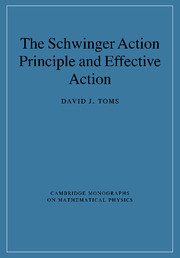Book contents
- Frontmatter
- Contents
- Preface
- 1 Action principle in classical mechanics
- 2 Action principle in classical field theory
- 3 Action principle in quantum theory
- 4 The effective action
- 5 Quantum statistical mechanics
- 6 Effective action at finite temperature
- 7 Further applications of the Schwinger action principle
- 8 General definition of the effective action
- Appendix 1 Mathematical appendices
- Appendix 2 Review of special relativity
- Appendix 3 Interaction picture
- Bibliography
- Index
1 - Action principle in classical mechanics
Published online by Cambridge University Press: 27 October 2009
- Frontmatter
- Contents
- Preface
- 1 Action principle in classical mechanics
- 2 Action principle in classical field theory
- 3 Action principle in quantum theory
- 4 The effective action
- 5 Quantum statistical mechanics
- 6 Effective action at finite temperature
- 7 Further applications of the Schwinger action principle
- 8 General definition of the effective action
- Appendix 1 Mathematical appendices
- Appendix 2 Review of special relativity
- Appendix 3 Interaction picture
- Bibliography
- Index
Summary
Euler–Lagrange equations
In classical mechanics we are usually interested in solving the equations of motion of a point particle under the action of some prescribed force. A method for doing this in a systematic way is given by Newton's equation F = ma, where F is the force applied, m is the mass, and a is the acceleration. Since the force is often a function of time t and the position x of the particle (it may also depend on velocity in some cases), and the acceleration a is given in terms of the vector x specifying the position of the particle by a Newton's equations of motion result in a set of ordinary differential equations for the path x(t) followed by the particle. The motion is completely specified if we give the position x(t0) = x0 and the velocity (t0) = v0 at some initial time t0. (Other conditions on the path are also possible. For example, we might specify the location of the particle at two different times.)
It is usually assumed that the path of the particle can be described by regarding x as a vector in the Euclidean space RD, and typically we are interested in the case D = 3. The components of x may be chosen to be the Cartesian coordinates of the curve x(t) that describes the motion of the particle parameterized by the time t.
- Type
- Chapter
- Information
- The Schwinger Action Principle and Effective Action , pp. 1 - 39Publisher: Cambridge University PressPrint publication year: 2007



